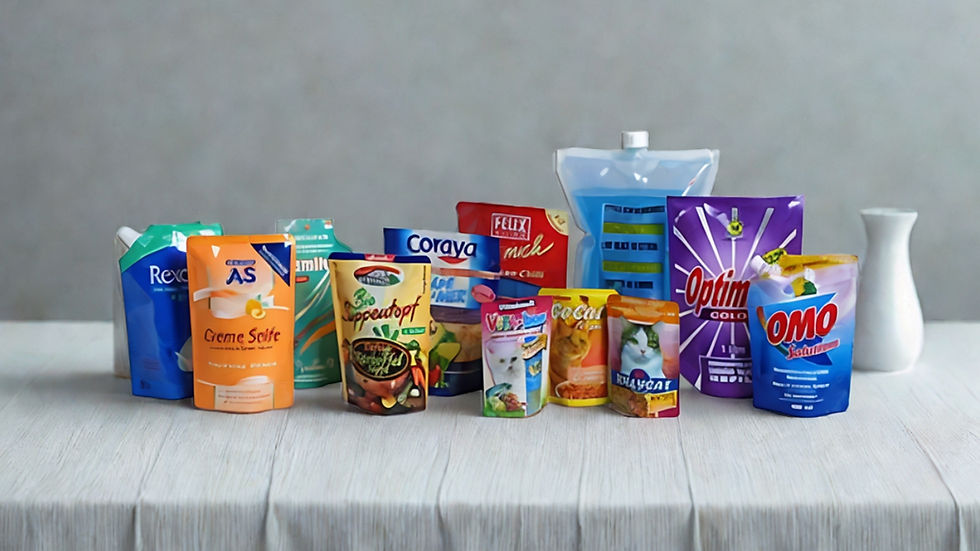How Multi-Colored Laminated Rolls Enhance Product Appeal and Shelf Presence
- mavtinstith7
- Aug 21, 2024
- 4 min read

In the bustling world of retail, where every product vies for consumer attention, standing out on the shelf is paramount. One of the most effective ways to achieve this is through visually striking packaging. Enter the multi-colored laminated roll—a game-changer in the packaging industry.
Introduction
Packaging is more than just a container for your product; it's a powerful marketing tool. Multi-colored laminated rolls offer a unique combination of durability and aesthetic appeal, making them a popular choice among packaging designers, product manufacturers, and brand managers. In this blog, we'll uncover what multi-colored laminated rolls are, their various types, and the factors to consider when choosing the right one for your needs.
What is a Multi-Colored Laminated Roll?
Multi-colored laminated rolls are composite materials made up of multiple layers of plastic film, such as polypropylene or polyester. These layers are bonded together to form a sturdy, flexible sheet that is then cut into rolls. These rolls can feature a variety of colors and designs, making them ideal for packaging, labeling, and decorative purposes. The primary function of these rolls is to protect products from external factors like moisture and dust while enhancing their visual appeal.
Types of Multi-Colored Laminated Rolls
Glossy Laminated Rolls
Glossy laminated rolls are known for their shiny, reflective surface that catches the eye. They are commonly used in packaging for high-end products like cosmetics, electronics, and gourmet food items. The glossy finish not only adds a touch of elegance but also makes colors appear more vibrant, thereby increasing shelf presence.
Glossy laminated rolls are typically made from polypropylene, which offers excellent clarity and gloss. This material is also resistant to oils and greases, making it ideal for food packaging. However, it's essential to note that the glossy surface may show fingerprints and smudges more easily, so consider this when choosing your packaging material.
Matte Laminated Rolls
Matte laminated rolls provide a more subdued, sophisticated look. Unlike their glossy counterparts, matte rolls have a non-reflective surface that gives a premium feel to the packaging. They are perfect for brands that aim for a minimalist, luxurious aesthetic.
Matte laminated rolls are often made from polyester, which offers better UV resistance than polypropylene. This makes them suitable for products that need to be displayed under bright lights or in direct sunlight. Additionally, matte finishes are less likely to show fingerprints and smudges, maintaining a clean appearance over time.
Holographic Laminated Rolls
Holographic laminated rolls are the epitome of eye-catching packaging. These rolls feature a holographic effect that changes colors when viewed from different angles, creating a dynamic and engaging visual experience. They are particularly popular in the packaging of toys, tech gadgets, and promotional items.
The holographic effect is achieved by embossing a pattern onto the laminated film, which is then coated with a thin layer of metal. This combination creates a dazzling display that captures consumer attention and sets your product apart from the competition. However, holographic laminated rolls can be more expensive, so consider your budget when opting for this type of packaging.
Metallic Laminated Rolls
Metallic laminated rolls offer a sleek, futuristic look that is hard to ignore. These rolls are coated with a thin layer of metal, typically aluminum, giving them a shiny, reflective surface. They are commonly used in the packaging of luxury items, automotive parts, and high-tech gadgets.
Metallic laminated rolls provide excellent barrier properties, protecting products from moisture, light, and oxygen. This makes them ideal for perishable goods like coffee, snacks, and pharmaceuticals. However, the metallic surface can be prone to scratching, so handle these rolls with care during the packaging process.
Factors to Consider When Choosing Multi-Colored Laminated Rolls
Material
The material of the laminated roll is a crucial factor to consider. Polypropylene is more cost-effective and offers excellent clarity, making it suitable for food packaging. On the other hand, polyester is more durable and provides better UV resistance, making it ideal for products displayed under bright lights or in direct sunlight. Choose the material that best suits your product's requirements.
Thickness
The thickness of the laminated roll determines its strength and durability. Thicker rolls provide more protection but can be more expensive. Consider the weight and type of product you will be packaging to determine the appropriate thickness. For example, heavier items like electronics may require thicker rolls, while lighter items like cosmetics can use thinner rolls.
Color and Design
Color and design play a significant role in capturing consumer attention and conveying your brand's message. Choose colors that represent your brand effectively and designs that enhance the overall appearance of your product. Keep in mind that the design should align with your target audience's preferences and expectations.
Labeling and Printing
If you plan to use the laminated roll for labeling purposes, ensure that the material is suitable for printing. Some materials may not hold ink well, resulting in smudged or faded labels. Consider the type of printing method you will use and ensure it is compatible with the laminated roll material.
Roll Size and Quantity
Laminated rolls come in various sizes, so it's essential to determine the appropriate size for your packaging needs. Consider factors such as product dimensions, storage space, and shipping requirements when choosing the size. Additionally, ordering in bulk may be more cost-effective than purchasing smaller quantities.











Comments